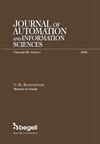基于认知映射脉冲过程模型的稳定不稳定加密货币汇率的自适应系统
Q3 Engineering
Journal of Automation and Information Sciences
Pub Date : 2021-03-01
DOI:10.34229/1028-0979-2021-2-2
引用次数: 0
摘要
本文基于因果关系建立了金融市场中加密货币的认知图(CM)。这是一个加权有向图,节点反映:加密货币汇率、加密货币交易量、加密货币用户数量、资本化规模、投资规模、加密货币投机规模、加密货币供需、间接利润、对加密货币的信心水平、加密货币汇率方差、使用加密货币时的整体风险水平。在此基础上,以差分方程组(罗伯茨方程)的形式建立了脉冲过程的动力学模型。选择CM脉冲过程的外部控制向量。它是通过改变以下CM节点坐标的资源形成的:加密货币供应、交易、资本化、投资和投机量。基于自动控制理论方法,在脉冲过程的闭环控制系统中进行控制设计,并由决策者实现。采用基于模态控制方法合成的多维离散状态控制器,生成所选的控制向量,通过改变CM节点的坐标直接影响CM节点,实现了CM脉冲过程的闭环控制系统。本文基于模态控制方法解决了加密货币汇率不稳定暂态过程的稳定系统设计问题。提出了一种基于递归最小二乘法的CM权值识别系统。研究了12节点CM中2、3、5控制模态控制的选择。本文章由计算机程序翻译,如有差异,请以英文原文为准。
AN ADAPTIVE SYSTEM FOR STABILIZING UNSTABLE CRYPTOCURRENCY RATE BASED ON A COGNITIVE MAP IMPULSE PROCESS MODEL
In this paper a cognitive map (CM) of the cryptocurrency in the financial market has been developed based on causal relationships. This is a weighted directed graph with nodes reflecting: the cryptocurrency rate, the volume of cryptocurrency trading, the number of cryptocurrency users, the volume of capitalization, the volume of investments, the volume of speculation in cryptocurrency, supply and demand for cryptocurrency, indirect profit, level of confidence in cryptocurrency, variance of the cryptocurrency rate, integral level of risks when using cryptocurrency. On the basis of the CM, a dynamic model of CM impulse processes is developed in the form of a system of difference equations (Roberts equations). The external control vector for the CM impulse process is selected. It is formed by varying the resources of the following CM nodes coordinates: cryptocurrency supply, trading, capitalization, investment and speculation volumes. Controls are designed in a closed-loop control system of the impulse process based on the automatic control theory methods and are implemented by a decision-maker. A closed-loop control system for the CM impulse process is implemented, which includes a multidimensional discrete state controller synthesized on the basis of the modal control method, which generates the selected control vector and directly affects respective CM nodes by varying their coordinates. The paper solves the problem of a stabilization system design for the unstable transient process of the cryptocurrency rate based on the modal control method. An identification system for the CM weights based on the recurrent least squares method has been developed. The options of modal control with two, three and five controls in the CM with 12 nodes are investigated.
求助全文
通过发布文献求助,成功后即可免费获取论文全文。
去求助
来源期刊

Journal of Automation and Information Sciences
AUTOMATION & CONTROL SYSTEMS-
自引率
0.00%
发文量
0
审稿时长
6-12 weeks
期刊介绍:
This journal contains translations of papers from the Russian-language bimonthly "Mezhdunarodnyi nauchno-tekhnicheskiy zhurnal "Problemy upravleniya i informatiki". Subjects covered include information sciences such as pattern recognition, forecasting, identification and evaluation of complex systems, information security, fault diagnosis and reliability. In addition, the journal also deals with such automation subjects as adaptive, stochastic and optimal control, control and identification under uncertainty, robotics, and applications of user-friendly computers in management of economic, industrial, biological, and medical systems. The Journal of Automation and Information Sciences will appeal to professionals in control systems, communications, computers, engineering in biology and medicine, instrumentation and measurement, and those interested in the social implications of technology.
 求助内容:
求助内容: 应助结果提醒方式:
应助结果提醒方式:


